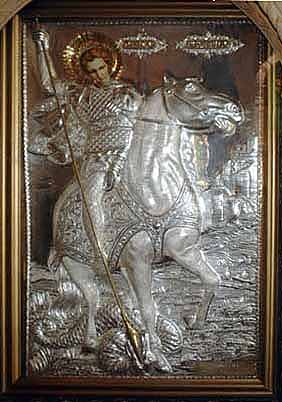![]()

Icon of St. George
in the Narthex. Silver and gilt overlay on egg tempera
painting.
Click on St. George's face, the dragon, and the princess to
view details.
In 275 AD, St. George was born of Christian parents in Lydda of Cappadocia in Palestine. He rose to the highest ranks of the Roman Legion. But then Emperor Diocletian, the great persecutor of Christians, demanded his soldiers offer pagan sacrifices as proof of their loyalty. As a Christian, George refused to obey this order, relinquished his commission, and openly confessed his faith. His steadfastness in enduring terrible tortures inspired courage in other Christians to stand by their faith and made many converts. He was beheaded on April 23, 303 AD at Nicomedia in Asia Minor.
As the fame of St. George spread throughout the Eastern world, he came to be invoked in time of trouble by Christians and Moslems alike. The icon depicts St. George as an equestrian slaying a dragon. The dragon represents either Satan or Diocletian. The princess in the background may symbolize the Church or Empress Alexandra. Returning Christians brought their devotion to Saint George back to Europe, and installed him as patron saint of England. Saint George is the patron saint of all who fight for righteousness.
"As the liberator of prisoners, and the protector of those in poverty, physician of the sick, and defender of ruling kings, O George, Triumphant Great Martyr, intercede with Christ our God , that our souls may be saved."--Apolytikion of Saint George